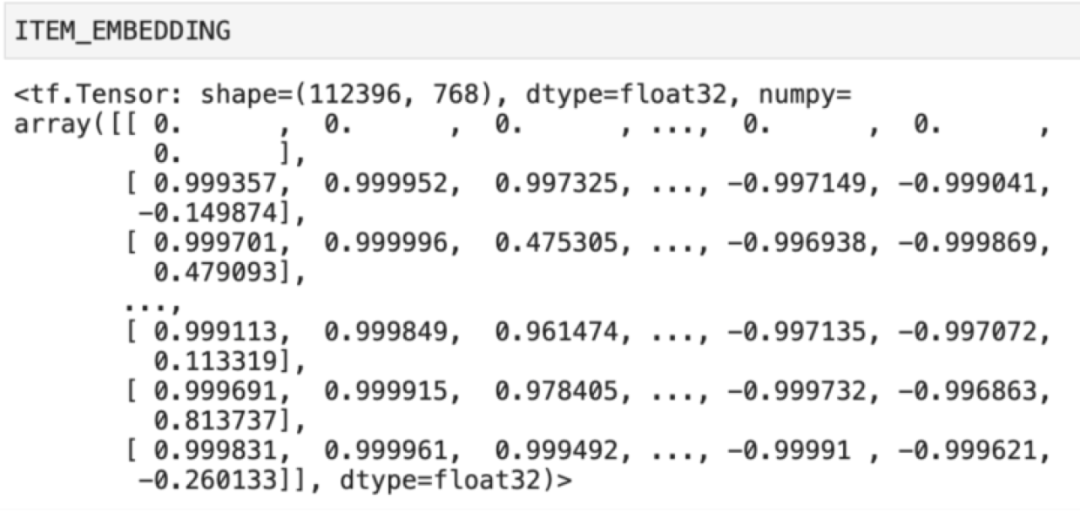支持多值带权重、稀疏、共享embedding权重的DSSM召回实现(tensorflow2)
作者 | xulu1352 目前在一家互联网公司从事推荐算法工作
编辑 | lily




关于DSSM模型原理及实现,网上已经有很多质量不错的参考文章了,比如王多鱼的实践DSSM召回(如果对dssm模型原理不熟,建议先阅读这篇文章,再看本文实践部分,本文主要讲实现),总结的非常不错,王多鱼这篇文章DSSM实践是基于浅梦大佬开源deepmatch包实现的,但是在推荐系统实践中如果直接调用别人的模型包会遇到诸多不便,需要在自己业务场景中做finetune;实际生产中,模型所用到的特征往往都是稀疏的,多值变长的,对有些特征我们还想让它们共享embedding,说到这里,我要非常感谢石塔西的这篇文章用TensorFlow实现支持多值、稀疏、共享权重的DeepFM,从这篇文章中,我得到很多启发;本文下面介绍的主要是自己从各位大佬那学习到的知识总结,并无什么创新点,希望对一些刚入坑的童鞋们有所帮助。好了,那我们开始,Talk is cheap, Show me the code.
虽然本文不讲模型原理,但是有两Tricks,还是值得提下,亲测有效,这两tricks在下文实现均有体现。

Emebdding标准化可以加速模型训练和提升检索效果。
通过引入超参数
微调超参数




为了逼近真实推荐系统场景的数据处理,这里人为构造部分实际生产数据样例作为演示;
样本
字段介绍:
act:为label数据 1:正样本,0:负样本
client_id: 用户id
post_id:物料item id 这里称为post_id
client_type:用户客户端类型
follow_topic_id: 用户关注话题分类id
all_topic_fav_7: 用户画像特征,用户最近7天对话题偏爱度刻画,kv键值对形式
topic_id: 物料所属的话题
read_post_id:用户最近阅读的物料id
预训练item embedding 向量
这里会有为每个item预训练生成一个embedding向量,存到embedding矩阵中,idx=0行,为一个默认值,当一个item因某些原因未生成其embedding向量,则用默认值0替代。
定义参数类型
我们将参数归三种类型单值离散型SparseFeat,如topic_id字段;稠密数值类型DenseFeat,如用户访问时间及用户embedding向量等;多值变长离散特征VarLenSparseFeat,如follow_topic_id或者带权重形式all_topic_fav_7;这里延用deepMatch开源包里定义输入变量方式, 需要注意的是,SparseFeat与VarLenSparseFeat类型的特征,如果想共享embedding权重向量,需要指定其与哪个category离散变量特征embedding参数共享,如这里我们想follow_topic_id与all_topic_fav_7里的id embedding与item的topic_id embedding权重共享一套,设置share_embed='topic_id'即可。
from collections import namedtuple, OrderedDictimport tensorflow as tfSparseFeat = namedtuple('SparseFeat', ['name', 'voc_size', 'share_embed','embed_dim', 'dtype'])DenseFeat = namedtuple('DenseFeat', ['name', 'pre_embed','reduce_type','dim', 'dtype'])VarLenSparseFeat = namedtuple('VarLenSparseFeat', ['name', 'voc_size', 'share_embed', 'weight_name', 'embed_dim','maxlen', 'dtype'])from collections import namedtuple, OrderedDictimport tensorflow as tfSparseFeat = namedtuple('SparseFeat', ['name', 'voc_size', 'share_embed','embed_dim', 'dtype'])DenseFeat = namedtuple('DenseFeat', ['name', 'pre_embed','reduce_type','dim', 'dtype'])VarLenSparseFeat = namedtuple('VarLenSparseFeat', ['name', 'voc_size', 'share_embed', 'weight_name', 'embed_dim','maxlen', 'dtype'])
定义DSSM输入变量参数
除了常见的特征,这里使用用户最近浏览的物料embedding向量的平均作为用户的一个特征即client_embed;我们将follow_topic_id,all_topic_fav7用到的topic_id embedding向量与item的topic_id对应的embedding向量共享,在实际应用中,相近语义的embedding权重共享是很有必要的,大大减少网络训练参数,防止过拟合。
feature_columns = [SparseFeat(name="topic_id", voc_size=700, share_embed=None, embed_dim=16, dtype='string'),SparseFeat(name='client_type', voc_size=2, share_embed=None, embed_dim=8,dtype='float32'),VarLenSparseFeat(name="follow_topic_id", voc_size=700, share_embed='topic_id',weight_name = None, embed_dim=16, maxlen=20,dtype='string'),VarLenSparseFeat(name="all_topic_fav_7", voc_size=700, share_embed='topic_id', weight_name = 'all_topic_fav_7_weight', embed_dim=16, maxlen=5,dtype='string'),DenseFeat(name='item_embed',pre_embed='post_id', reduce_type=None, dim=768, dtype='float32'),DenseFeat(name='client_embed',pre_embed='read_post_id', reduce_type='mean', dim=768, dtype='float32'),]# 用户特征及贴子特征user_feature_columns_name = ["follow_topic_id", 'all_topic_fav_7','client_type','client_embed']item_feature_columns_name = ["topic_id", 'post_type','item_embed',]user_feature_columns = [col for col in feature_columns if col.name in user_feature_columns_name ]item_feature_columns = [col for col in feature_columns if col.name in item_feature_columns_name ]
构造训练tf.dataset数据
首先加载预训练 item embedding向量及离散特征vocabulary
def get_item_embed(file_names):item_bert_embed = []item_id = []for file in file_names:with open(file, 'r') as f:for line in f:feature_json = json.loads(line)item_bert_embed.append(feature_json['post_id'])item_id.append(feature_json['values'])item_id2idx = tf.lookup.StaticHashTable(tf.lookup.KeyValueTensorInitializer(keys=item_id,values=range(1, len(item_id)+1),key_dtype=tf.string,value_dtype=tf.int32),default_value=0)item_bert_embed = [[0.0]*768] + item_bert_embeditem_embedding = tf.constant(item_bert_embed, dtype=tf.float32)return item_id2idx, item_embedding# 获取item embedding及其查找关系ITEM_ID2IDX, ITEM_EMBEDDING = get_item_embed(file_names)# 定义离散特征集合 ,离散特征vocabularyDICT_CATEGORICAL = {"topic_id": [str(i) for i in range(0, 700)],"client_type": [0,1]}
然后,tf.dataset构造
DEFAULT_VALUES = [[0],[''],[''],[0.0], [''], [''], [''],['']]COL_NAME = ['act', 'client_id', 'post_id', 'client_type', 'follow_topic_id', 'all_topic_fav_7', 'topic_id','read_post_id']def _parse_function(example_proto):item_feats = tf.io.decode_csv(example_proto, record_defaults=DEFAULT_VALUES, field_delim='\t')parsed = dict(zip(COL_NAME, item_feats))feature_dict = {}for feat_col in feature_columns:if isinstance(feat_col, VarLenSparseFeat):if feat_col.weight_name is not None:kvpairs = tf.strings.split([parsed[feat_col.name]], ',').values[:feat_col.maxlen]kvpairs = tf.strings.split(kvpairs, ':')kvpairs = kvpairs.to_tensor()feat_ids, feat_vals = tf.split(kvpairs, num_or_size_splits=2, axis=1)feat_vals= tf.strings.to_number(feat_vals, out_type=tf.float32)feature_dict[feat_col.name] = feat_idsfeature_dict[feat_col.weight_name] = feat_valselse:feat_ids = tf.strings.split([parsed[feat_col.name]], ',').values[:feat_col.maxlen]feat_ids = tf.reshape(feat_ids, shape=[-1])feature_dict[feat_col.name] = feat_idselif isinstance(feat_col, SparseFeat):feature_dict[feat_col.name] = parsed[feat_col.name]elif isinstance(feat_col, DenseFeat):if feat_col.pre_embed is None:feature_dict[feat_col.name] = parsed[feat_col.name]elif feat_col.reduce_type is not None:keys = tf.strings.split(parsed[feat_col.pre_embed], ',')emb = tf.nn.embedding_lookup(params=ITEM_EMBEDDING, ids=ITEM_ID2IDX.lookup(keys))emb = tf.reduce_mean(emb,axis=0) if feat_col.reduce_type == 'mean' else tf.reduce_sum(emb,axis=0)feature_dict[feat_col.name] = embelse:emb = tf.nn.embedding_lookup(params=ITEM_EMBEDDING, ids=ITEM_ID2IDX.lookup(parsed[feat_col.pre_embed]))feature_dict[feat_col.name] = embelse:raise "unknown feature_columns...."label = parsed['act']return feature_dict, labelpad_shapes = {}pad_values = {}for feat_col in feature_columns:if isinstance(feat_col, VarLenSparseFeat):max_tokens = feat_col.maxlenpad_shapes[feat_col.name] = tf.TensorShape([max_tokens])pad_values[feat_col.name] = ''if feat_col.weight_name is not None:pad_shapes[feat_col.weight_name] = tf.TensorShape([max_tokens])pad_values[feat_col.weight_name] = tf.constant(-1, dtype=tf.float32)# no need to pad labelselif isinstance(feat_col, SparseFeat):if feat_col.dtype == 'string':pad_shapes[feat_col.name] = tf.TensorShape([])pad_values[feat_col.name] = '9999'else:pad_shapes[feat_col.name] = tf.TensorShape([])pad_values[feat_col.name] = 0.0elif isinstance(feat_col, DenseFeat):if feat_col.pre_embed is None:pad_shapes[feat_col.name] = tf.TensorShape([])pad_values[feat_col.name] = 0.0else:pad_shapes[feat_col.name] = tf.TensorShape([feat_col.dim])pad_values[feat_col.name] = 0.0pad_shapes = (pad_shapes, (tf.TensorShape([])))pad_values = (pad_values, (tf.constant(0, dtype=tf.int32)))filenames= tf.data.Dataset.list_files(['/recall_user_item_act.csv'])dataset = filenames.flat_map(lambda filepath: tf.data.TextLineDataset(filepath).skip(1))batch_size = 1024dataset = dataset.map(_parse_function, num_parallel_calls=60)dataset = dataset.repeat()dataset = dataset.shuffle(buffer_size = batch_size*2) # 在缓冲区中随机打乱数据dataset = dataset.padded_batch(batch_size = batch_size,padded_shapes = pad_shapes,padding_values = pad_values) # 每1024条数据为一个batch,生成一个新的Datasetsdataset = dataset.prefetch(buffer_size=tf.data.experimental.AUTOTUNE)# 验证集filenames_val= tf.data.Dataset.list_files(['/recall_user_item_act_val.csv'])dataset_val = filenames_val.flat_map(lambda filepath: tf.data.TextLineDataset(filepath).skip(1))val_batch_size = 1024dataset_val = dataset_val.map(_parse_function, num_parallel_calls=60)dataset_val = dataset_val.padded_batch(batch_size = val_batch_size,padded_shapes = pad_shapes,padding_values = pad_values) # 每1024条数据为一个batch,生成一个新的Datasetsdataset_val = dataset_val.prefetch(buffer_size=tf.data.experimental.AUTOTUNE)
经过上述逻辑代码预处理后,原始样本csv文件中数据格式已经转化为如下的形式(这里拿batch_size=1 举例),kv形式的特征被拆分为两个Input输入变量一个是category离散ID(如all_topic_fav_7),一个是其对应的weight(如all_topic_fav_7_weight),他们最终被输入到tf.nn.embedding_lookup_sparse(self.embedding,sp_ids=idx, sp_weights=val, combiner='sum') 这个api 对应的sp_ids,sp_weights参数中去。
# next(iter(dataset))({'topic_id': <tf.Tensor: shape=(1,), dtype=string, numpy=array([b'278'], dtype=object)>,'client_type': <tf.Tensor: shape=(1,), dtype=float32, numpy=array([0.], dtype=float32)>,'follow_topic_id': <tf.Tensor: shape=(1, 20), dtype=string, numpy=array([[b'572', b'92', b'62', b'37', b'35', b'34', b'33', b'32', b'31',b'30', b'29', b'68', b'67', b'65', b'24', b'20', b'16', b'15',b'13', b'12']], dtype=object)>,'all_topic_fav_7': <tf.Tensor: shape=(1, 5), dtype=string, numpy=array([[b'502', b'278', b'177', b'1', b'']], dtype=object)>,'all_topic_fav_7_weight': <tf.Tensor: shape=(1, 5), dtype=float32, numpy=array([[ 0.3443, 0.0868, 0.0719, 0.497 , -1. ]], dtype=float32)>,'item_embed': <tf.Tensor: shape=(1, 768), dtype=float32, numpy=array([[ 0.999586, 0.999861, 0.995566, 0.892292, 0.848516, 0.815888,-0.860286, -0.871219, 0.982316, -0.999692, 0.999998, 0.999589,......-0.943752, 0.999957, -0.990231, 0.999377, -0.997795, 0.999498,-0.995729, 0.701236, 0.991473, 0.946505, -0.996337, 0.999991,0.991516, -0.997269, -0.993377, -0.9964 , -0.99972 , 0.880781]],dtype=float32)>,'client_embed': <tf.Tensor: shape=(1, 768), dtype=float32, numpy=array([[ 0.79698 , 0.7999152 , 0.78845704, 0.6598178 , 0.59617054,0.5318628 , -0.5754676 , -0.7469004 , 0.78916025, -0.7958456 ,......0.7989754 , -0.7971929 , -0.0165708 , 0.7924882 , 0.73336124,-0.794997 , 0.7999618 , 0.7634414 , -0.792517 , -0.762231 ,-0.7960204 , -0.7998554 , 0.37363502]], dtype=float32)>},<tf.Tensor: shape=(1,), dtype=int32, numpy=array([1], dtype=int32)>)




# 离散多值查找表 转稀疏SparseTensor >> EncodeMultiEmbedding >>tf.nn.embedding_lookup_sparse的sp_ids参数中class SparseVocabLayer(Layer):def __init__(self, keys, **kwargs):super(SparseVocabLayer, self).__init__(**kwargs)vals = tf.range(1, len(keys) + 1)vals = tf.constant(vals, dtype=tf.int32)keys = tf.constant(keys)self.table = tf.lookup.StaticHashTable(tf.lookup.KeyValueTensorInitializer(keys, vals), 0)def call(self, inputs):input_idx = tf.where(tf.not_equal(inputs, ''))input_sparse = tf.SparseTensor(input_idx, tf.gather_nd(inputs, input_idx), tf.shape(inputs, out_type=tf.int64))return tf.SparseTensor(indices=input_sparse.indices,values=self.table.lookup(input_sparse.values),dense_shape=input_sparse.dense_shape)# 自定义Embedding层,初始化时,需要传入预先定义好的embedding矩阵,好处可以共享embedding矩阵class EncodeMultiEmbedding(Layer):def __init__(self, embedding, has_weight=False, **kwargs):super(EncodeMultiEmbedding, self).__init__(**kwargs)self.has_weight = has_weightself.embedding = embeddingdef build(self, input_shape):super(EncodeMultiEmbedding, self).build(input_shape)def call(self, inputs):if self.has_weight:idx, val = inputscombiner_embed = tf.nn.embedding_lookup_sparse(self.embedding,sp_ids=idx, sp_weights=val, combiner='sum')else:idx = inputscombiner_embed = tf.nn.embedding_lookup_sparse(self.embedding,sp_ids=idx, sp_weights=None, combiner='mean')return tf.expand_dims(combiner_embed, 1)def get_config(self):config = super(EncodeMultiEmbedding, self).get_config()config.update({'has_weight': self.has_weight})return config# 稠密权重转稀疏格式输入到tf.nn.embedding_lookup_sparse的sp_weights参数中class Dense2SparseTensor(Layer):def __init__(self):super(Dense2SparseTensor, self).__init__()def call(self, dense_tensor):weight_idx = tf.where(tf.not_equal(dense_tensor, tf.constant(-1, dtype=tf.float32)))weight_sparse = tf.SparseTensor(weight_idx, tf.gather_nd(dense_tensor, weight_idx), tf.shape(dense_tensor, out_type=tf.int64))return weight_sparsedef get_config(self):config = super(Dense2SparseTensor, self).get_config()return config# 自定义dnese层含BN, dropoutclass CustomDense(Layer):def __init__(self, units=32, activation='tanh', dropout_rate =0, use_bn=False, seed=1024, tag_name="dnn", **kwargs):self.units = unitsself.activation = activationself.dropout_rate = dropout_rateself.use_bn = use_bnself.seed = seedself.tag_name = tag_namesuper(CustomDense, self).__init__(**kwargs)#build方法一般定义Layer需要被训练的参数。def build(self, input_shape):self.weight = self.add_weight(shape=(input_shape[-1], self.units),initializer='random_normal',trainable=True,name='kernel_' + self.tag_name)self.bias = self.add_weight(shape=(self.units,),initializer='random_normal',trainable=True,name='bias_' + self.tag_name)if self.use_bn:self.bn_layers = tf.keras.layers.BatchNormalization()self.dropout_layers = tf.keras.layers.Dropout(self.dropout_rate)self.activation_layers = tf.keras.layers.Activation(self.activation, name= self.activation + '_' + self.tag_name)super(CustomDense,self).build(input_shape) # 相当于设置self.built = True#call方法一般定义正向传播运算逻辑,__call__方法调用了它。def call(self, inputs, training = None, **kwargs):fc = tf.matmul(inputs, self.weight) + self.biasif self.use_bn:fc = self.bn_layers(fc)out_fc = self.activation_layers(fc)return out_fc#如果要让自定义的Layer通过Functional API 组合成模型时可以序列化,需要自定义get_config方法,保存模型不写这部分会报错def get_config(self):config = super(CustomDense, self).get_config()config.update({'units': self.units, 'activation': self.activation, 'use_bn': self.use_bn,'dropout_rate': self.dropout_rate, 'seed': self.seed, 'name': self.tag_name})return config# cos 相似度计算层class Similarity(Layer):def __init__(self, gamma=1, axis=-1, type_sim='cos', **kwargs):self.gamma = gammaself.axis = axisself.type_sim = type_simsuper(Similarity, self).__init__(**kwargs)def build(self, input_shape):# Be sure to call this somewhere!super(Similarity, self).build(input_shape)def call(self, inputs, **kwargs):query, candidate = inputsif self.type_sim == "cos":query_norm = tf.norm(query, axis=self.axis)candidate_norm = tf.norm(candidate, axis=self.axis)cosine_score = tf.reduce_sum(tf.multiply(query, candidate), -1)cosine_score = tf.divide(cosine_score, query_norm * candidate_norm + 1e-8)cosine_score = tf.clip_by_value(cosine_score, -1, 1.0) * self.gammareturn tf.expand_dims(cosine_score, 1)def compute_output_shape(self, input_shape):return (None, 1)def get_config(self, ):config = {'gamma': self.gamma, 'axis': self.axis, 'type': self.type_sim}base_config = super(Similarity, self).get_config()return base_config.uptate(config)# 自定损失函数,加权交叉熵损失class WeightedBinaryCrossEntropy(tf.keras.losses.Loss):"""Args:pos_weight: Scalar to affect the positive labels of the loss function.weight: Scalar to affect the entirety of the loss function.from_logits: Whether to compute loss from logits or the probability.reduction: Type of tf.keras.losses.Reduction to apply to loss.name: Name of the loss function."""def __init__(self, pos_weight=1.2, from_logits=False,reduction=tf.keras.losses.Reduction.AUTO,name='weighted_binary_crossentropy'):super().__init__(reduction=reduction, name=name)self.pos_weight = pos_weightself.from_logits = from_logitsdef call(self, y_true, y_pred):y_true = tf.cast(y_true, tf.float32)ce = tf.losses.binary_crossentropy(y_true, y_pred, from_logits=self.from_logits)[:, None]ce = ce * (1 - y_true) + self.pos_weight * ce * (y_true)# ce =tf.nn.weighted_cross_entropy_with_logits(# y_true, y_pred, self.pos_weight, name=None# )return cedef get_config(self, ):config = {'pos_weight': self.pos_weight, 'from_logits': self.from_logits, 'name': self.name}base_config = super(WeightedBinaryCrossEntropy, self).get_config()return base_config.uptate(config)




# 定义model输入特征def build_input_features(features_columns, prefix=''):input_features = OrderedDict()for feat_col in features_columns:if isinstance(feat_col, DenseFeat):if feat_col.pre_embed is None:input_features[feat_col.name] = Input([1], name=feat_col.name)else:input_features[feat_col.name] = Input([feat_col.dim], name=feat_col.name)elif isinstance(feat_col, SparseFeat):if feat_col.dtype == 'string':input_features[feat_col.name] = Input([None], name=feat_col.name, dtype=feat_col.dtype)else:input_features[feat_col.name] = Input([1], name=feat_col.name, dtype=feat_col.dtype)elif isinstance(feat_col, VarLenSparseFeat):input_features[feat_col.name] = Input([None], name=feat_col.name, dtype='string')if feat_col.weight_name is not None:input_features[feat_col.weight_name] = Input([None], name=feat_col.weight_name, dtype='float32')else:raise TypeError("Invalid feature column in build_input_features: {}".format(feat_col.name))return input_features# 构造自定义embedding层matrixdef build_embedding_matrix(features_columns):embedding_matrix = {}for feat_col in features_columns:if isinstance(feat_col, SparseFeat) or isinstance(feat_col, VarLenSparseFeat):if feat_col.dtype == 'string':vocab_name = feat_col.share_embed if feat_col.share_embed else feat_col.namevocab_size = feat_col.voc_sizeembed_dim = feat_col.embed_dimif vocab_name not in embedding_matrix:embedding_matrix[vocab_name] = tf.Variable(initial_value=tf.random.truncated_normal(shape=(vocab_size, embed_dim),mean=0.0,stddev=0.0, dtype=tf.float32), trainable=True, name=vocab_name+'_embed')return embedding_matrix# 构造自定义 embedding层def build_embedding_dict(features_columns, embedding_matrix):embedding_dict = {}for feat_col in features_columns:if isinstance(feat_col, SparseFeat):if feat_col.dtype == 'string':vocab_name = feat_col.share_embed if feat_col.share_embed else feat_col.nameembedding_dict[feat_col.name] = EncodeMultiEmbedding(embedding=embedding_matrix[vocab_name],name='EncodeMultiEmb_' + feat_col.name)elif isinstance(feat_col, VarLenSparseFeat):vocab_name = feat_col.share_embed if feat_col.share_embed else feat_col.nameif feat_col.weight_name is not None:embedding_dict[feat_col.name] = EncodeMultiEmbedding(embedding=embedding_matrix[vocab_name],has_weight=True,name='EncodeMultiEmb_' + feat_col.name)else:embedding_dict[feat_col.name] = EncodeMultiEmbedding(embedding=embedding_matrix[vocab_name],name='EncodeMultiEmb_' + feat_col.name)return embedding_dict# dense 与 embedding特征输入def input_from_feature_columns(features, features_columns, embedding_dict):sparse_embedding_list = []dense_value_list = []for feat_col in features_columns:if isinstance(feat_col, SparseFeat) or isinstance(feat_col, VarLenSparseFeat):if feat_col.dtype == 'string':vocab_name = feat_col.share_embed if feat_col.share_embed else feat_col.namekeys = DICT_CATEGORICAL[vocab_name]_input_sparse = SparseVocabLayer(keys)(features[feat_col.name])if isinstance(feat_col, SparseFeat):if feat_col.dtype == 'string':_embed = embedding_dict[feat_col.name](_input_sparse)else:_embed = Embedding(feat_col.voc_size+1, feat_col.embed_dim,embeddings_regularizer=tf.keras.regularizers.l2(0.5),name='Embed_' + feat_col.name)(features[feat_col.name])sparse_embedding_list.append(_embed)elif isinstance(feat_col, VarLenSparseFeat):if feat_col.weight_name is not None:_weight_sparse = Dense2SparseTensor()(features[feat_col.weight_name])_embed = embedding_dict[feat_col.name]([_input_sparse, _weight_sparse])else:_embed = embedding_dict[feat_col.name](_input_sparse)sparse_embedding_list.append(_embed)elif isinstance(feat_col, DenseFeat):dense_value_list.append(features[feat_col.name])else:raise TypeError("Invalid feature column in input_from_feature_columns: {}".format(feat_col.name))return sparse_embedding_list, dense_value_listdef concat_func(inputs, axis=-1):if len(inputs) == 1:return inputs[0]else:return Concatenate(axis=axis)(inputs)def combined_dnn_input(sparse_embedding_list, dense_value_list):if len(sparse_embedding_list) > 0 and len(dense_value_list) > 0:sparse_dnn_input = Flatten()(concat_func(sparse_embedding_list))dense_dnn_input = Flatten()(concat_func(dense_value_list))return concat_func([sparse_dnn_input, dense_dnn_input])elif len(sparse_embedding_list) > 0:return Flatten()(concat_func(sparse_embedding_list))elif len(dense_value_list) > 0:return Flatten()(concat_func(dense_value_list))else:raise "dnn_feature_columns can not be empty list"




def DSSM(user_feature_columns,item_feature_columns,user_dnn_hidden_units=(256, 256, 128),item_dnn_hidden_units=(256, 256, 128),user_dnn_dropout=(0, 0, 0),item_dnn_dropout=(0, 0, 0),out_dnn_activation='tanh',gamma=1.2,dnn_use_bn=False,seed=1024,metric='cos'):"""Instantiates the Deep Structured Semantic Model architecture.Args:user_feature_columns: A list containing user's features used by the model.item_feature_columns: A list containing item's features used by the model.user_dnn_hidden_units: tuple,tuple of positive integer , the layer number and units in each layer of user toweritem_dnn_hidden_units: tuple,tuple of positive integer, the layer number and units in each layer of item towerout_dnn_activation: Activation function to use in deep netdnn_use_bn: bool. Whether use BatchNormalization before activation or not in deep netuser_dnn_dropout: tuple of float in [0,1), the probability we will drop out a given user tower DNN coordinate.item_dnn_dropout: tuple of float in [0,1), the probability we will drop out a given item tower DNN coordinate.seed: integer ,to use as random seed.gamma: A useful hyperparameter for Similarity layermetric: str, "cos" for cosinereturn: A TF Keras model instance."""features_columns = user_feature_columns + item_feature_columns# 构建 embedding_dictembedding_matrix = build_embedding_matrix(features_columns)embedding_dict = build_embedding_dict(features_columns, embedding_matrix)# user 特征 处理user_features = build_input_features(user_feature_columns)user_inputs_list = list(user_features.values())user_dense_value_list = input_from_feature_columns(user_features,embedding_dict)user_dnn_input = combined_dnn_input(user_sparse_embedding_list, user_dense_value_list)# item 特征 处理item_features = build_input_features(item_feature_columns)item_inputs_list = list(item_features.values())item_dense_value_list = input_from_feature_columns(item_features,embedding_dict)item_dnn_input = combined_dnn_input(item_sparse_embedding_list, item_dense_value_list)# user towerfor i in range(len(user_dnn_hidden_units)):if i == len(user_dnn_hidden_units) - 1:user_dnn_out = CustomDense(units=user_dnn_hidden_units[i],dropout_rate=user_dnn_dropout[i],use_bn=dnn_use_bn,activation=out_dnn_activation, name='user_embed_out')(user_dnn_input)breakuser_dnn_input = CustomDense(units=user_dnn_hidden_units[i],dropout_rate=user_dnn_dropout[i],use_bn=dnn_use_bn,activation='relu', name='dnn_user_'+str(i))(user_dnn_input)# item towerfor i in range(len(item_dnn_hidden_units)):if i == len(item_dnn_hidden_units) - 1:item_dnn_out = CustomDense(units=item_dnn_hidden_units[i],dropout_rate=item_dnn_dropout[i],use_bn=dnn_use_bn, activation=out_dnn_activation, name='item_embed_out')(item_dnn_input)breakitem_dnn_input = CustomDense(units=item_dnn_hidden_units[i],dropout_rate=item_dnn_dropout[i],use_bn=dnn_use_bn,activation='relu', name='dnn_item_'+str(i))(item_dnn_input)score = Similarity(type_sim=metric,gamma=gamma)([user_dnn_out, item_dnn_out])output = tf.keras.layers.Activation("sigmoid", name="dssm_out")(score)# score = Multiply()([user_dnn_out, item_dnn_out])# output = Dense(1, activation="sigmoid",name="dssm_out")(score)model = Model(inputs=user_inputs_list + item_inputs_list, outputs=output)user_inputs_list)item_inputs_list)user_dnn_out)item_dnn_out)return model



训练模型
model= DSSM(user_feature_columns,item_feature_columns,user_dnn_hidden_units=(256, 256, 128),item_dnn_hidden_units=(256, 256, 128),user_dnn_dropout=(0, 0, 0),item_dnn_dropout=(0, 0, 0),out_dnn_activation='tanh',gamma=1,dnn_use_bn=False,seed=1024,metric='cos')='adagrad',loss={"dssm_out": WeightedBinaryCrossEntropy(),},loss_weights=[1.0,],metrics={"dssm_out": [tf.keras.metrics.AUC(name='auc')]})log_dir = '/mywork/tensorboardshare/logs/' + datetime.datetime.now().strftime("%Y%m%d-%H%M%S")tbCallBack = TensorBoard(log_dir=log_dir, # log 目录histogram_freq=0, # 按照何等频率(epoch)来计算直方图,0为不计算write_graph=True, # 是否存储网络结构图write_images=True,# 是否可视化参数update_freq='epoch',embeddings_freq=0,embeddings_layer_names=None,embeddings_metadata=None,profile_batch = 40)##total_train_sample = 115930total_test_sample = 1181train_steps_per_epoch=np.floor(total_train_sample/batch_size).astype(np.int32)test_steps_per_epoch = np.ceil(total_test_sample/val_batch_size).astype(np.int32)history_loss = model.fit(dataset, epochs=1,steps_per_epoch=train_steps_per_epoch,validation_data=dataset_val, validation_steps=test_steps_per_epoch,verbose=1,callbacks=[tbCallBack])
模型结构summary
保存模型
# 用户塔 item塔定义user_embedding_model = Model(inputs=model.user_input, outputs=model.user_embedding)item_embedding_model = Model(inputs=model.item_input, outputs=model.item_embedding)# 保存tf.keras.models.save_model(user_embedding_model,"/Recall/DSSM/models/dssmUser/001/")tf.keras.models.save_model(item_embedding_model,"/Recall/DSSM/models/dssmItem/001/")
获取user embedding 及item embedding
user_query = {'all_topic_fav_7': np.array([['294', '88', '60', '1']]),'all_topic_fav_7_weight':np.array([[ 0.0897, 0.2464, 0.0928, 0.5711,]]),'follow_topic_id': np.array([['75', '73', '74', '92', '62', '37', '35', '34', '33',]),'client_type': np.array([0.]),'client_embed': np.array([[-9.936600e-02, 2.752400e-01, -4.314620e-01, 3.393100e-02,-5.263000e-02, -4.490300e-01, -3.641180e-01, -3.545410e-01,-2.315470e-01, 4.641480e-01, 3.965120e-01, -1.670170e-01,-5.480000e-03, -1.646790e-01, 2.522832e+00, -2.946590e-01,......-1.151946e+00, -4.008270e-01, 1.521650e-01, -3.524520e-01,4.836160e-01, -1.190920e-01, 5.792700e-02, -6.148070e-01,-7.182930e-01, -1.351920e-01, 2.048980e-01, -1.259220e-01]])}item_query = {'topic_id': np.array(['1']),'item_embed': np.array([[-9.936600e-02, 2.752400e-01, -4.314620e-01, 3.393100e-02,-5.263000e-02, -4.490300e-01, -3.641180e-01, -3.545410e-01,-2.315470e-01, 4.641480e-01, 3.965120e-01, -1.670170e-01,......-1.151946e+00, -4.008270e-01, 1.521650e-01, -3.524520e-01,4.836160e-01, -1.190920e-01, 5.792700e-02, -6.148070e-01,-7.182930e-01, -1.351920e-01, 2.048980e-01, -1.259220e-01]]),}user_embs = user_embedding_model.predict(user_query)item_embs = item_embedding_model.predict(item_query)# 结果:# user_embs:# array([[ 0.80766946, 0.13907856, -0.37779272, 0.53268254, -0.3095821 ,# 0.2213103 , -0.24618168, -0.7127088 , 0.4502724 , 0.4282374 ,# -0.36033005, 0.43310016, -0.29158285, 0.8743557 , 0.5113318 ,# 0.26994514, -0.35604447, 0.33559784, -0.28052363, 0.38596702,# 0.5038488 , -0.32811972, -0.5471834 , -0.07594685, 0.7006799 ,# -0.24201767, 0.31005877, -0.06173763, -0.28473467, 0.61975694,......# -0.714099 , -0.5384026 , 0.38787717, -0.4263588 , 0.30690318,# 0.24047776, -0.01420124, 0.15475503, 0.77783686, -0.43002903,# 0.52561694, 0.37806144, 0.18955356, -0.37184635, 0.5181224 ,# -0.18585253, 0.05573007, -0.38589332, -0.7673693 , -0.25266737,# 0.51427466, 0.47647673, 0.47982445]], dtype=float32)# item_embs:# array([[-6.9417924e-01, -3.9942840e-01, 7.2445291e-01, -5.8977932e-01,# -5.8792406e-01, 5.3883100e-01, -7.8469634e-01, 6.8996024e-01,# -7.6087400e-02, -4.4855604e-01, 8.4910756e-01, -4.7288817e-01,# -9.0812451e-01, -4.0452164e-01, 8.8695991e-01, -7.9177713e-01,......# -9.7515762e-01, -5.2411711e-01, 9.2708725e-01, -1.3903661e-01,# 7.8691095e-01, -8.0726832e-01, -7.3851186e-01, 2.7774110e-01,# -4.1870885e-02, 4.7335419e-01, 3.4424815e-01, -5.8394599e-01]],# dtype=float32)



我们这里向量召回检索框架用的是Milvus,用户的UE是线上实时获取的,item的embedding是异步获取存到Milvus平台上。
石塔西:用TensorFlow实现支持多值、稀疏、共享权重的DeepFM https://github.com/shenweichen/
由于微信平台算法改版,公号内容将不再以时间排序展示,如果大家想第一时间看到我们的推送,强烈建议星标我们和给我们多点点【在看】。星标具体步骤为:
(1)点击页面最上方"AINLP",进入公众号主页。
(2)点击右上角的小点点,在弹出页面点击“设为星标”,就可以啦。
感谢支持,比心

推荐阅读
征稿启示| 200元稿费+5000DBC(价值20个小时GPU算力)
完结撒花!李宏毅老师深度学习与人类语言处理课程视频及课件(附下载)
模型压缩实践系列之——bert-of-theseus,一个非常亲民的bert压缩方法
文本自动摘要任务的“不完全”心得总结番外篇——submodular函数优化
斯坦福大学NLP组Python深度学习自然语言处理工具Stanza试用
关于AINLP
AINLP 是一个有趣有AI的自然语言处理社区,专注于 AI、NLP、机器学习、深度学习、推荐算法等相关技术的分享,主题包括文本摘要、智能问答、聊天机器人、机器翻译、自动生成、知识图谱、预训练模型、推荐系统、计算广告、招聘信息、求职经验分享等,欢迎关注!加技术交流群请添加AINLPer(id:ainlper),备注工作/研究方向+加群目的。
阅读至此了,分享、点赞、在看三选一吧🙏









